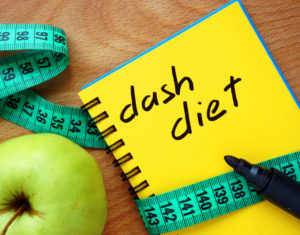The DASH Diet
 The DASH Diet
The DASH Diet
In 1997, the DASH Diet was published in the New England Journal of Medicine entitled “A Clinical Trial of the Effects of Dietary Patterns on Blood Pressure.”
This trial was called the Dietary Approaches to Stop Hypertension (DASH). This study showed that “A diet rich in fruits, vegetables, and low-fat dairy foods and with reduced saturated and total fat can substantially lower blood pressure. This diet offers an additional nutritional approach to preventing and treating hypertension.”
The DASH trial enrolled patients who were at least 22 years of age who had systolic blood pressures less than 160 mmHg and a diastolic blood pressure between 80 and 95 mmHg. They had to be off blood pressure medications. 459 participants were randomized to one of the three diet groups.
2/3s of the study population were racial or ethnic minority. Patients were excluded if they had any of the following:
- poorly controlled diabetes mellitus
- hyperlipidemia
- a cardiovascular event within the previous six months
- chronic diseases that might interfere with participation
- pregnancy or lactation
- a body-mass index (BMI) of more than 35
- use of medications that affect blood pressure
- unwillingness to stop taking vitamin and mineral supplements or antacids containing magnesium or calcium
- renal insufficiency
- alcoholic-beverage intake of more than 14 drinks per week
There were 3 phases: screening, run-in, and intervention
- Screening: 3 visits, a pair of blood pressures was measured at each visit.
- Run-in: 3 week period where all patients were given the “control diet.” Blood pressure was monitored during the last 2 weeks. 24-hour urine was collected once.
- Intervention: subjects were randomly assigned to 1 of 3 different diets. Blood pressure was measured once a week during the 1st six weeks. During the last 2 weeks blood pressure was measured 5 times. 24-hour urine was collected once.
There were 5 enrollment groups. The last four of the five groups (everyone except the first group) used a 24-hour ambulatory blood pressure monitor for assessing blood pressure.
Diets
Control Diet: macronutrients were what is typical in the Standard American Diet. Potassium, magnesium, and calcium consumption were in the bottom 25th percentile of the standard American diet. Fiber consumption was considered average for the standard diet as well.
Fruits & Vegetables Diet: More fruits & vegetables than the control diet, fewer snacks. Potassium & magnesium content was in the 75th percentile for the standard American diet.
Combination Diet: rich in fruits, vegetables, & low-fat dairy foods; low saturated fat, total fat, and cholesterol. Potassium, magnesium, and calcium intake was near the 75th percentile. High amounts of fiber and protein.
The sodium content was around 3 grams in each of the 3 groups.
Controlled Feeding
All food was prepped in one of the research facilities kitchens. During the week, the participants ate either lunch or dinner at the research facility. At that point, they received a cooler containing their other meals for the day to be eaten elsewhere. They ate all of their weekend meals off site and received all of their weekend food on the preceding Friday. They were limited to 2 alcoholic 3 caffeinated beverages daily. They could also use up to 0.4g of sodium (provided in 2 packets) daily. Their weight was kept stable by adjusting their caloric intake.
Each diet had a 7-day menu with 21 meals. There were 4 different calorie levels: 1600, 2100, 2600, and 3100 kcal). All diets were standardized and prepared with the same brands of foods.
Participants recorded their adherence daily.
Conclusion
Fruits & Vegetables Diet: Reduced blood pressure 2.8/1.1 mmHg (p<0.001)
Combination Diet: Reduced blood pressure 5.5/3 mmHg (p<0.001)
The bottom line, blood pressure was shown to be reduced in both groups and the effect was about what you would see with one blood pressure medication. If everybody followed the DASH diet, it is estimated that coronary heart disease would decrease 15% and stroke would decrease 27%.







